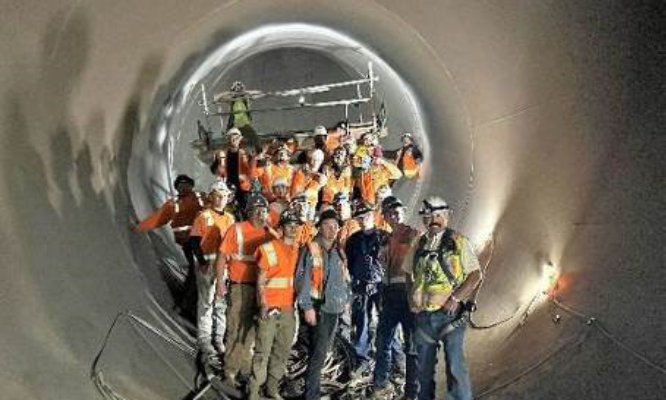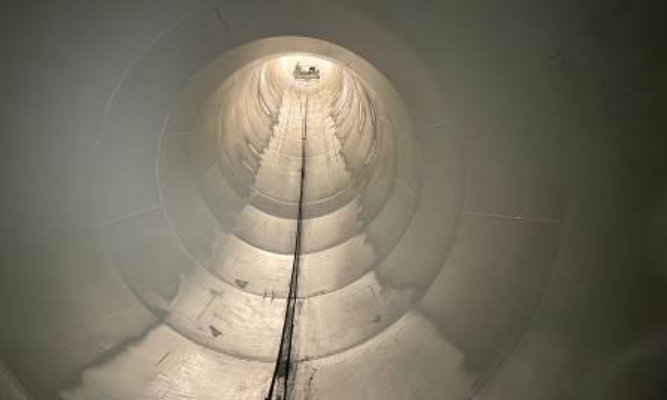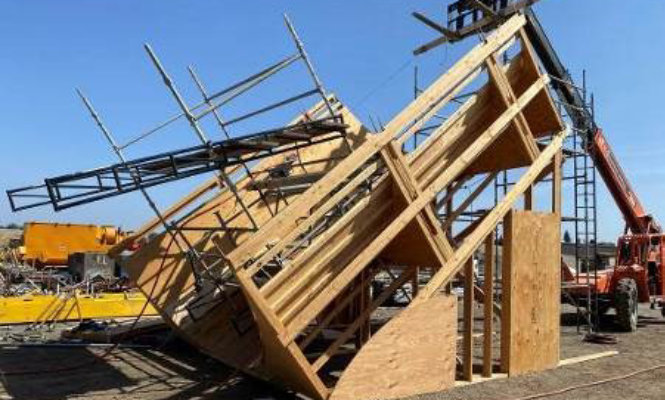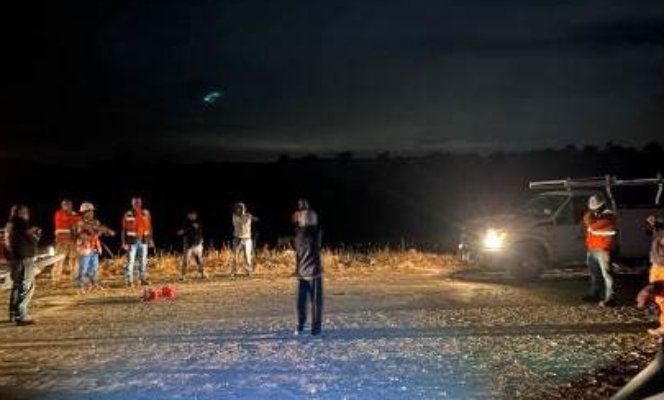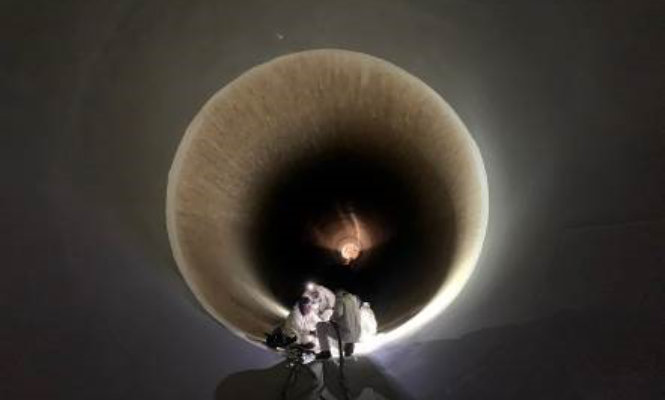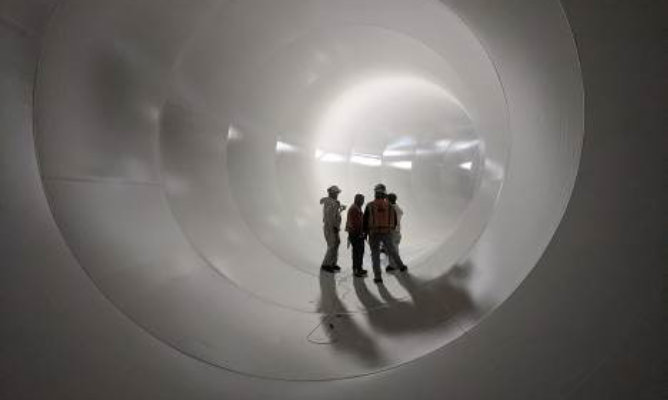Penstock Relining Extends Don Pedro Dam Power Plant Life
Restoration Adds Another 50 Years of Service for Half-Century-Old Hydroelectric Infrastructure
by Scott Helfand, Senior Sales Representative, Sherwin-Williams Protective & Marine

The Challenge: Rehabilitating a 50-Year-Old Penstock with Tight Timelines & Extreme Conditions
Tucked inside a cavernous, 16.5-foot-diameter enclosed pipe 300 feet below ground, a brave crew of applicators and engineers faced difficult conditions – from lead containment protection measures to steep inclines to a global pandemic – to reline a 50-year-old penstock. Their valiant effort will enable the penstock to operate reliably for another 50 years, doubling the life of this crucial element of the Don Pedro Dam and enabling the dam’s hydroelectric power plant to continue serving Northern California’s carbon-free clean energy needs.
The challenging project required a contractor team that wasn’t afraid of working inside a nearly quarter-mile length of steel-lined penstock with a 53-degree angle drop mid-way in the system. This configuration would require special rigging so workers could perform activities from a suspended scaffolding system. Due to the required window for snow run off, the crew would have brief working windows of just 45 days each over two calendar years to rehabilitate 1,300 feet of pipe. This work included removing a thick coal tar epoxy with a red lead-based primer from every square inch of the pipe walls and then prepping, cleaning and relining the structure.
Few contractors are up to this sort of challenge. In fact, the Turlock and Modesto Irrigation Districts (TID and MID), owners of the Don Pedro Project, sought proposals from 15 heavy industry coating contractors but received just one bid – from coating and specialty contractor F.D. Thomas (FDT).
“We were confident in taking on this project because we’ve done a lot of penstocks, although not many with this steep of an incline. We knew we were up for the planning and problem solving required to do the project safely and properly,” said Corey Hall, Project Manager, FDT. “That’s how the crew earned the nickname of the ‘Ameri-Cans’ – because they ‘can’ do it when no one else wanted to try.”
This can-do attitude resulted in a newly relined and restored penstock featuring a durable epoxy lining that’s expected to double the penstock’s service life to at least 100 years. The efforts of the “Ameri-Cans” (Figure 1) also helped the project win top honors in the 2022 Sherwin-Williams Impact Awards program.
The Solution: Combining Safety, Innovation and Durable Penstock Coatings
The penstock relining project is part of a long-term Life Extension and Upgrade Project that began in 2010 for the Don Pedro Dam and its supporting powerhouse infrastructure, which is located about 120 miles due east of San Francisco in Tuolumne County. Over more than a decade, various restoration projects have brought the power tunnel and control bulkhead valves back to like-new condition. During that time, crews performed mechanical overhauls on dam and powerhouse equipment. These projects replaced various power tunnel bulkhead gates and diversion tunnel service gates and four turbine shutoff valves, along with relining the entire power tunnel penstock.
“Restoring the power plant penstock lining was a critical part for this overall life extension project,” said Daniel Orosco, PE, Senior Power Generation Engineer for the TID Power Plant Engineering Department. “This penstock carries water from the dam’s reservoir through hydroelectric turbines to generate a total plant capacity of 203 megawatts of energy. We have been entrusted with this asset, so we needed to ensure this critical piece of infrastructure can operate for another 50 years without surface corrosion or deterioration.”
At 580 feet tall, the Don Pedro Dam is the tenth highest dam in California. Its height and water feedstock layout created an especially difficult scenario for FDT’s engineering and application team to overcome inside the penstock. While the entire project entailed 1,300 feet of pipe, approximately 200 feet was installed at a drastic 53-degree angle, allowing water to gain the momentum required to turn four hydroelectric turbines for the power plant. This incline necessitated some practice and procedural alterations on FDT’s end between the first and second years of the project.
During the project’s first 45-day stretch in 2020, FDT completed about 500 feet of the penstock relining in a barely sloped section of pipe. Various obstacles, including access needs and water infiltration, caused some delays. However, FDT was able to progress rapidly thereafter, with most of the surface preparation and coating application activities performed using automated equipment. This equipment was also used in 2021 to complete the remaining 375 feet of straight pipe before the steeply inclined section, as well as about 225 feet of pipe downstream from the incline.
To overcome the physical configuration of the sloped pipe, FDT created a scaffolding platform that could be raised and lowered via pulleys (Figure 2). To get the rig just right, FDT built a wooden replica of a portion of the steep pipe section using the same dimensions as the structure (Figure 3). This allowed the crew to determine how to safely erect the platform inside the angled pipe and keep it horizontal while performing manual coating removals and applications.
The Approach: Creating a Safe Penstock Relining Work Environment in a Confined Space
With the entire relining project taking place within a confined space, environmental precautions were already warranted. However, extra safeguards were required due to the need to contain lead when removing the previous lining. In addition, FDT had to manage a major hurdle related to water infiltrating the workspace. These obstacles required careful planning to ensure worker safety (Figure 4) They also required redundancy so backup systems could immediately take over if the primary systems went down.
First, FDT approached the environmental needs, focusing on air quality and temperature control. Rather than condition the entire penstock, FDT created temporary bulkheads inside to section off large working areas. A pair of heavy-duty dehumidifiers and heaters then conditioned these spaces, bringing the humidity and temperature to suitable levels to hold the SSPC-SP 5 bare metal condition and for breathing and applying coatings.
Containment needs were especially strict due to the need to capture lead-based coal tar epoxy waste during surface blasting. To complete this work, crewmembers had to don special suits and be fully respirated. They also had to be decontaminated inside an airlock before leaving the structure.
Adding to the difficulty of the project, FDT was unable to achieve a positive water shutoff inside the penstock. Even with the gate valves closed, water continued to flow into the penstock from the reservoir lake above a concrete-lined section and through the main power tunnel bulkhead gate at around 125 gallons per minute. This speedbump forced FDT to create a temporary catch berm inside the penstock to capture the water before pumping it 300 feet directly up the shaft and back into the reservoir. Addressing this issue and building a 200-foot staircase to enable worker access from the bottom of the dam added a seven-day learning curve to the project’s first year, limiting the team’s progress and forcing FDT to do a little more than planned during the second year.
Due to the importance of having suitable air conditions inside the confined workspace, FDT established a secondary backup generator system that ensured the dehumidifiers, heaters and pumps were always on. If the primary system went down, the generator would handle the load immediately, so anyone inside the penstock could evacuate. No one would be allowed back inside until the team restored power to the primary generator. The backup system was also necessary to keep the pumps for the temporary berm running so the penstock wouldn’t get wet.
Getting the necessary equipment to working areas throughout the pipe was also a challenge due to having only two access points. Crewmembers therefore had to either lower equipment and materials 300 feet down from the top of the access shaft with a crane or haul them up the newly installed 200-foot staircase before moving them into place for blasting and spraying. The heated spray hoses also had to be 1,000 feet long to enable access to working areas while minimizing equipment moves within the confined space, again overcome by the FDT team based on the type of pumps used.
Surface Preparation: Removing Old Coatings and Inspecting the Penstock
After bulkheading a large section of the penstock and conditioning the space, FDT’s applicators were set to work on preparing the metal penstock for the new lining system. Crewmembers used robotic and manual blasting methods (Figure 5) to remove the coal tar epoxy and any other residues from the pipe walls, collecting, sorting and disposing the lead-contaminated debris along the way. Progress was slow due to the tightly adhered original coating, as well as a heavy amount of mill scale on the top areas of the penstock, which required extra effort to remove. Ultimately, FDT was able to achieve an SSPC-SP 5 white metal blast clean surface on the entirety of the pipe. After blasting one blocked-off area of the pipe, crewmembers could move on to preparing the next bulkheaded section while applicators lined the previous one.
Following removal of the old lining, inspectors found the exposed metal pipe to be in very good condition with minimal pitting and few repairs needed. The old, obsolete lining technology had definitely done its job over its 50-year life, allowing FDT to quickly move to the lining applications.
Lining Application: Epoxy Coating for Long-Term Penstock Protection
Anticipating another 50 years of service life for the restored penstock, the owners specified the use of a durable ultra-high solids epoxy amine lining, Sherwin-Williams Sherplate™ PW Epoxy. The coating has a high film-build capability, as well as high edge-retention capabilities, enabling it to be used for stripe coating welds, edges and corners before completing full lining applications. The 100% solids potable water-rated lining is also compliant with NSF/ANSI/CAN 61 and NSF/ANSI/CAN 600. In addition, it contains no solvents, which was critical for maintaining air quality in the pipe and meeting confined space entry requirements for the job.
“When the Sherplate PW product was specified for the project, we couldn’t think of using anything else for this type of application,” noted Hall. “We do a lot of tanks, and this is the best product we’ve used, so we knew it would be right for the penstock.”
To ensure full coverage on the welded pipe seams located every 40 feet throughout the penstock, FDT applicators first applied a stripe coat of Sherplate PW on each seam using brushes and rollers before spraying the rest of the area. Applicators were able to spray-apply the lining both manually and robotically in one pass, building the coating to a minimum thickness of 30 mils dry film thickness (DFT) to ensure long-term protection.
Final inspection (Figure 6) of the application involved holiday spark testing on every square inch of the newly lined penstock. Workers traced an electrified brush across the pipe walls, watching for any sparks that may indicate a holiday or thin area in the lining. Touchup needs were rare following inspections, but they were especially easy to manage given the Sherplate PW product’s 14-day recoat window (Figure 7).
“The application process from start to finish was incredibly efficient as we were able to complete most spraying robotically, and we had very few repairs to make. Due to the coating’s fast dry time, our applicators were able to line a section of pipe in one pass, wait a day and then spark test that area. Then, they could reapply coatings immediately to address any holidays or repair needs without having to reblast,” said Hall.
Coatings and lining inspection services provider Bay Area Coating Consultants, Inc. (BACC) served as the owner’s eyes on the project, working diligently to secure the best possible outcome for the environment, verify surface preparations and confirm the final coating thickness. BACC embedded with FDT to ensure direct, immediate access to work areas, enabling continuous forward progress on the job. The firm even added a second inspector for 11 days to accommodate the extended 24-hour shifts required at the end of the project.
The Results: On-Time Restored Penstock Expected to Last Another 50 Years
The Sherplate PW lining material’s 24-hour return to service time also helped the team during both years of the project. FDT had a 45-day window to complete all activities, which brought the crew right down to the wire each time. That meant completing full lining removal and installation as far as possible during the first year, which ended up being just 500 feet of pipe, and scrambling to complete the remaining 800 feet, including the difficult sloped section, during year two.
“We were coating right up until we had to turn the penstock back over for operation,” said Hall. “We essentially finished coating applications, pulled our equipment out, removed the temporary berm, and they opened the gate. Having only a day’s wait to enable full immersion service of the lining was critical.”
“A significant amount of planning, executing and overcoming obstacles allowed this team to return the penstock to operation right on schedule for both years of the project,” noted TID’s Orosco. “This contractor brought experience and a willingness to execute to the project. At the contractor’s request, additional resources were brought in to work 11 full 24-hour days at the end to secure a finish date. The trust they had earned with the owner’s project manager enabled me to go to bat for them and find a way to staff the required work window. It was impressive to see how quickly the team progressed while overcoming the significant obstacles of water infiltration, remote work sites, a steep incline and tight deadlines. I tell people that the one thing I never heard during this, the most difficult project of my career was, ‘I can’t.’ I was proud to have worked alongside them.”
For more than half a century, the Don Pedro Dam has reliably served as an irrigation basin for productive farmland and an important source for Northern California’s clean energy needs. Following FDT’s restoration work on the dam’s penstock, this critical piece of infrastructure for the hydroelectric power plant is expected to last at least another 50 years. That’s double the life. And it’s all thanks to the “Ameri-Cans” for being willing to go where other contractors weren’t.
ABOUT THE AUTHOR
Scott Helfand is a Senior Sales Representative for Sherwin-Williams Protective & Marine. He has been with the company for more than 20 years and covers Northern California and Northern Nevada. He is an AMPP Certified Coatings Inspector. Contact: Scott.M.Helfand@sherwin.com.
Our Water & Wastewater Expertise
Explore our industry solutions and technology to help protect your assets.
LEARN MOREProduct Lookup
Find out more about our innovative coatings for a variety of industries.
FIND A PRODUCT